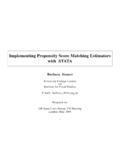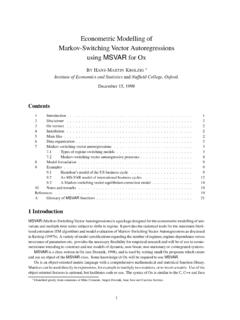Transcription of EC 823: Applied Econometrics
1 VAR, SVAR and VECM modelsChristopher F BaumEC 823: Applied EconometricsBoston college , Spring 2013 Christopher F baum (BC / DIW)VAR, SVAR and VECM modelsBoston college , Spring 20131 / 61 Vector autoregressive modelsVector autoregressive (VAR) modelsAp-th order vector autoregression, orVAR(p), with exogenousvariablesxcan be written as:yt=v+A1yt 1+ +Apyt p+B0xt+B1Bt 1+ +Bsxt s+utwhereytis a vector ofKvariables, each modeled as function ofplagsof those variables and, optionally, a set of exogenous assume thatE(ut) =0,E(utu t) = andE(utu s) =0 t6= F baum (BC / DIW)VAR, SVAR and VECM modelsBoston college , Spring 20132 / 61 Vector autoregressive modelsIf the VAR is stable (see commandvarstable) we can rewrite theVAR in moving average form as:yt= + i=0 Dixt i+ i=0 iut iwhich is the vector moving average (VMA) representation of the VAR,where all past values ofythave been substituted out.
2 TheDimatricesare the dynamic multiplier functions, or transfer functions. Thesequence of moving average coefficients iare the simpleimpulse-response functions (IRFs) at F baum (BC / DIW)VAR, SVAR and VECM modelsBoston college , Spring 20133 / 61 Vector autoregressive modelsEstimation of the parameters of the VAR requires that the variables inytandxtare covariance stationary, with their first two moments finiteand time-invariant. If the variables inytare not covariance stationary,but their first differences are, they may be modeled with a vector errorcorrection model, or the absence of exogenous variables, the disturbancevariance-covariance matrix contains all relevant information aboutcontemporaneous correlation among the variables inyt. VARs may bereduced-formVARs, which do not account for this contemporaneouscorrelation.
3 They may berecursiveVARs, where theKvariables areassumed to form a recursive dynamic structural model where eachvariable only depends upon those above it in the vectoryt. Or, theymay bestructuralVARs, where theory is used to place restrictions onthe contemporaneous F baum (BC / DIW)VAR, SVAR and VECM modelsBoston college , Spring 20134 / 61 Vector autoregressive modelsStata has a complete suite of commands for fitting and forecastingvector autoregressive (VAR) models and structural vectorautoregressive (SVAR) models. Its capabilities include estimating andinterpreting impulse response functions (IRFs), dynamic multipliers,and forecast error vector decompositions (FEVDs).Subsidiary commands allow you to check the stability condition of VARor SVAR estimates; to compute lag-order selection statistics for VARs;to perform pairwise Granger causality tests for VAR estimates; and totest for residual autocorrelation and normality in the disturbances forecasts may be computed and graphed after VAR or F baum (BC / DIW)VAR, SVAR and VECM modelsBoston college , Spring 20135 / 61 Vector autoregressive modelsStata svarbasiccommand allows you to fit a simple reduced-formVAR without constraints and graph the impulse-response functions(IRFs).
4 The more generalvarcommand allows for constraints to beplaced on the allows you to select the appropriate lag orderfor the VAR; commandvarwlecomputes Wald tests to determinewhether certain lags can be excluded;varlmarchecks forautocorrelation in the disturbances; andvarstablechecks whetherthe stability conditions needed to compute IRFs and FEVDs F baum (BC / DIW)VAR, SVAR and VECM modelsBoston college , Spring 20136 / 61 Vector autoregressive modelsIRFs, OIRFs and FEVDsIRFs, OIRFs and FEVDsImpulse response functions, or IRFs, measure the effects of a shock toan endogenous variable on itself or on another endogenous sirfcommands can compute five types of IRFs:simpleIRFs,orthogonalizedIRFs,cumul ativeIRFs,cumulativeorthogonalizedIRFs andstructuralIRFs. We defined the simple IRFin an earlier forecast error variance decomposition (FEVD) measures thefraction of the forecast error variance of an endogenous variable thatcan be attributed to orthogonalized shocks to itself or to anotherendogenous F baum (BC / DIW)VAR, SVAR and VECM modelsBoston college , Spring 20137 / 61 Vector autoregressive modelsIRFs, OIRFs and FEVDsTo analyze IRFs and FEVDs in Stata, you estimate a VAR model anduseirf createto estimate the IRFs and FEVDs and store them in afile.
5 This step is done automatically by thevarbasiccommand, butmust be done explicitly after thevarorsvarcommands. You maythen useirf graph,irf tableor otherirfanalysis commandsto examine IRFs to be computed, the VAR must be stable. The simple IRFsshown above have a drawback: they give the effect over time of aone-time unit increase to one of the shocks, holding all else to the extent the shocks are contemporaneously correlated, theother shocks cannot be held constant, and the VMA form of the VARcannot have a causal F baum (BC / DIW)VAR, SVAR and VECM modelsBoston college , Spring 20138 / 61 Vector autoregressive modelsOrthogonalized innovationsOrthogonalized innovationsWe can overcome this difficulty by takingE(utu t) = , the covariancematrix of shocks, and finding a matrixPsuch that =PP andP 1 P 1=IK.
6 The vector of shocks may then beorthogonalizedbyP 1. For a pure VAR, without exogenous variables,yt= + i=0 iut i= + i=0 iPP 1ut i= + i=0 iP 1ut i= + i=0 iwt iChristopher F baum (BC / DIW)VAR, SVAR and VECM modelsBoston college , Spring 20139 / 61 Vector autoregressive modelsOrthogonalized innovationsSims (Econometrica, 1980) suggests thatPcan be written as theCholesky decomposition of 1, and IRFs based on this choice areknown as theorthogonalizedIRFs. As a VAR can be considered to bethe reduced form of a dynamic structural equation (DSE) model,choosingPis equivalent to imposing a recursive structure on thecorresponding DSE model. Theorderingof the recursive structure isthat imposed in the Cholesky decomposition, which is that in which theendogenous variables appear in the VAR F baum (BC / DIW)VAR, SVAR and VECM modelsBoston college , Spring 201310 / 61 Vector autoregressive modelsOrthogonalized innovationsAs this choice is somewhat arbitrary, you may want to explore theOIRFs resulting from a different ordering.
7 It is not necessary, usingvarandirf create, to reestimate the VAR with a different ordering,as theorder()option ofirf createwill apply the Choleskydecomposition in the specified as the OIRFs are sensitive to the ordering of variables, the FEVD sare defined in terms of a particular causal there are additional (strictly) exogenous variables in the VAR, thedynamic multiplier functions or transfer functions can be measure the impact of a unit change in the exogenous variableon the endogenous variables over time. They are generated byfcastcomputeand graphed withfcast F baum (BC / DIW)VAR, SVAR and VECM modelsBoston college , Spring 201311 / 61 Vector autoregressive modelsvarbasicvarbasicFor a simple VAR estimation, you need only specify thevarbasicvarlistcommand. The number of lags, which is given as anumlist,defaults to(1 2).
8 Note that you must list every lag to be included; forinstancelags(4)would only include the fourth lag, whereaslags(1/4)would include the first four theusmacro1dataset, let us estimate a basic VAR for the firstdifferences of log real investment, log real consumption and log realincome through 2005q4. By default, the command will produce agraph of the orthogonalized IRFs (OIRFs) for 8 steps ahead. You maychoose a different horizon with thestep( ) F baum (BC / DIW)VAR, SVAR and VECM modelsBoston college , Spring 201312 / 61 Vector autoregressive modelsvarbasic. use usmacro1. varbasic if tin(,2005q4)Vector autoregressionSample: 1959q4 - 2005q4 No. of obs = 185 Log likelihood = AIC = = HQIC = (Sigma_ml) = SBIC = Parms RMSE R-sq chi2 P>chi2D_lrgrossinv 7.
9 017503 7 .006579 7 .007722 Std. Err. z P>|z| [95% Conf. Interval] .0977977 .0031962 ..0981167 ..2556723 .0655963 .2567412 ..2399165 ..2349968 ..0027881 ..0367601 ..03688 ..0961018 ..0965036 ..0901796 .0120043 ..0883304 ..001048 .0038326 ..0431482 .0393818 ..0432889 ..1128022 .1866933 ..1132738 .0154149 ..1058508 .1036802 ..0012301.
10 0014314 .0062533 Christopher F baum (BC / DIW)VAR, SVAR and VECM modelsBoston college , Spring 201313 / 61 Vector autoregressive 2024680246802468varbasic, , , , , , , , , , , , , , , , , , CIorthogonalized irfstepGraphs by i rfnam e, i m pul s e v ari abl e, and res pons e v ari abl eChristopher F baum (BC / DIW)VAR, SVAR and VECM modelsBoston college , Spring 201314 / 61 Vector autoregressive modelsvarbasicAs any of the VAR estimation commands save the estimated IRFs,OIRFs and FEVDs in , you may examine the FEVDs with agraph command. These items may also be tabulated with theirftableandirf ctablecommands. The latter command allows youto juxtapose tabulated values, such as the OIRF and FEVD for aparticular pair of variables, while theirf cgraphcommand allowsyou to do the same for irf graph fevd, lstep(1)Christopher F baum (BC / DIW)VAR, SVAR and VECM modelsBoston college , Spring 201315 / 61 Vector autoregressive , , , , , , , , , , , , , , , , , , CIfraction of mse due to impulsestepGraphs by i rfnam e, i m pul s e v ari abl e, and res pons e v ari abl eChristopher F baum (BC / DIW)VAR, SVAR and VECM modelsBoston college , Spring 201316 / 61 Vector autoregressive modelsvarbasicAfter producing any graph in Stata, you may save it in Stata s internalformat usinggraph savefilename.









